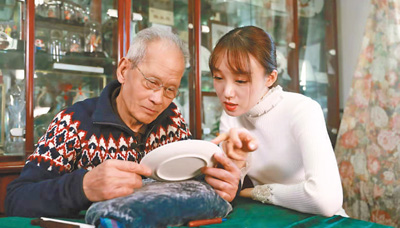

Since 2014, Xicheng district of Beijing has been recruiting volunteers with a passion for intangible cultural heritages, so that they can learn traditional skills from their inheritors and pass them on to the next generation.

Chen Yongchang (left), an inheritor of Beijing porcelain carving, discusses with his student. (FIle photo)
These volunteers of different ages and occupations have helped bring fresh impetus to the development of intangible cultural heritage, enabling them to enter the lives of ordinary people.
Beijing’s Xicheng district is rich in intangible cultural heritage resources. By 2019, there were 36 national and 67 municipal intangible cultural heritage protection projects, and 208 such projects in Xicheng district, covering 10 categories announced by the Ministry of Culture and Tourism.
However, some inheritors of representative intangible cultural heritage are of a very advanced age, and the number of individual project successors is relatively small, which has become an important factor restricting the inheritance and development of intangible cultural heritage.
How can we help rejuvenate the cultural heritage handed down from generation to generation? In 2014, the volunteer recruitment activity for intangible cultural heritage was launched in Xicheng district, and volunteers were openly recruited in five non-heritage projects: Beijing palace carpet weaving skills, Beijing porcelain carving, Yu straw weaving, painted clay sculpture and facial painting, and opera helmet making skills.
"We answered hundreds of phone calls a day,” said Yang Fei, director of the intangible cultural heritage protection center in Xicheng district, noting that the original plan was for five people to be recruited for each project, but more than 1,000 people signed up in just a few days. After an on-site assessment, 45 students were shortlisted.
Over the past seven years, 308 volunteers have been trained and recruited for a total of 36 intangible cultural heritage projects. The teaching process for the inheritors was also filmed and uploaded to Chinese microblogging website Weibo, prompting new enthusiasm to learn about China's intangible cultural heritage online.
"Volunteers are recruited to build bridges between inheritors and enthusiasts, which can better carry forward the cultural heritage," Yang said.
Initially, it was believed that it would be mostly elderly people who would be most enthusiastic about intangible cultural heritage, but surprisingly, there were many young people in the classrooms. Sun Huiyao was one of them.
Despite his heavy academic workload, the 15-year-old high school student has never missed his weekly dough shaping class. Two years ago, he became very interested in ventriloquism after learning the intangible cultural heritage from its inheritor.
This year, Sun and his mother Guo Chunlei were both shortlisted as volunteers. Sun, who likes to draw, is studying dough sculpture; while Guo, a doctor, chose to learn how to make medicinal incense.
"The participation of volunteers brings new strength to intangible cultural heritage," said Yang, adding, ”We will continue to explore new ways for the inheritance of intangible cultural heritage and enable it to have more long-term vitality."
 Fire brigade in Shanghai holds group wedding
Fire brigade in Shanghai holds group wedding Tourists enjoy ice sculptures in Datan Town, north China
Tourists enjoy ice sculptures in Datan Town, north China Sunset scenery of Dayan Pagoda in Xi'an
Sunset scenery of Dayan Pagoda in Xi'an Tourists have fun at scenic spot in Nanlong Town, NW China
Tourists have fun at scenic spot in Nanlong Town, NW China Harbin attracts tourists by making best use of ice in winter
Harbin attracts tourists by making best use of ice in winter In pics: FIS Alpine Ski Women's World Cup Slalom
In pics: FIS Alpine Ski Women's World Cup Slalom Black-necked cranes rest at reservoir in Lhunzhub County, Lhasa
Black-necked cranes rest at reservoir in Lhunzhub County, Lhasa China's FAST telescope will be available to foreign scientists in April
China's FAST telescope will be available to foreign scientists in April "She power" plays indispensable role in poverty alleviation
"She power" plays indispensable role in poverty alleviation Top 10 world news events of People's Daily in 2020
Top 10 world news events of People's Daily in 2020 Top 10 China news events of People's Daily in 2020
Top 10 China news events of People's Daily in 2020 Top 10 media buzzwords of 2020
Top 10 media buzzwords of 2020 Year-ender:10 major tourism stories of 2020
Year-ender:10 major tourism stories of 2020 No interference in Venezuelan issues
No interference in Venezuelan issues
 Biz prepares for trade spat
Biz prepares for trade spat
 Broadcasting Continent
Broadcasting Continent Australia wins Chinese CEOs as US loses
Australia wins Chinese CEOs as US loses